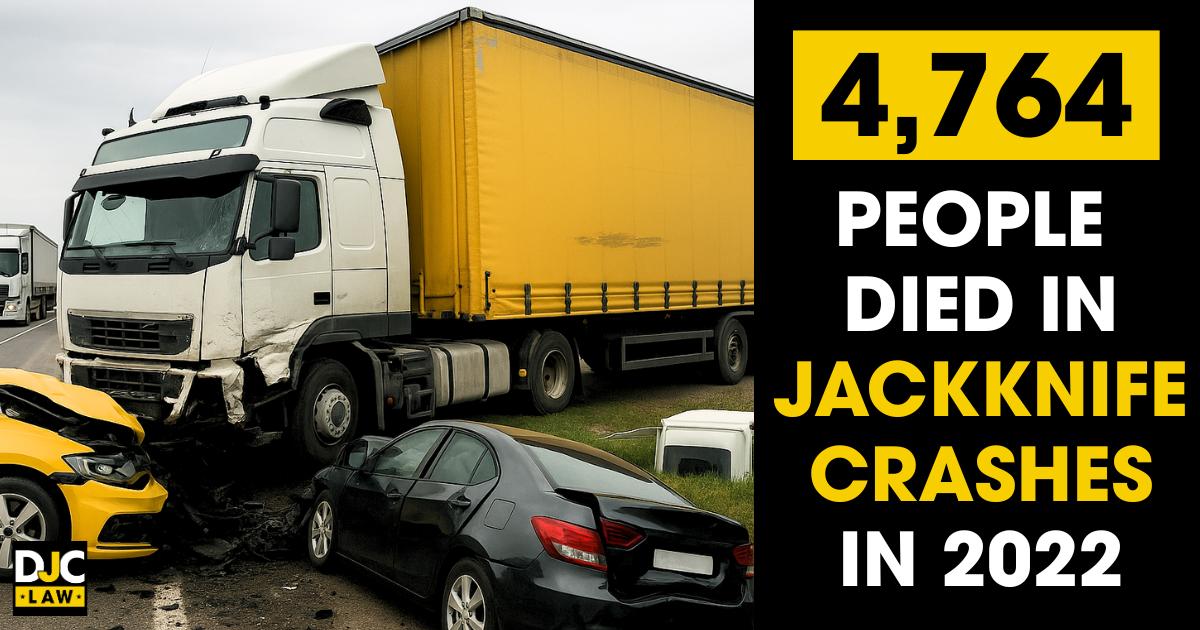
Jackknifing is a type of truck accident with devastating consequences. It’s where the truck and trailer fold in on themselves to create a V shape, crushing anything unfortunate enough to be inside this area and slamming against anything within the trailer’s turning circle.
Truck accidents are among the deadliest due to the sheer size of these vehicles. It’s why the IIHS found that 4,764 people died in these crashes in 2022. Of course, the jackknife phenomenon is just one type of accident.
In this guide, we’ll discuss what these accidents are, why they happen, and the consequences if you find yourself in this situation. If you’ve been involved in such an incident, consulting a skilled truck accident lawyer can help protect your rights and ensure you receive fair compensation.

Key Takeaways
- Jackknife accidents occur when a truck trailer swings outward on its trailer slew and toward the front vehicle, forming a V shape.
- The most common causes of these accidents are human error, environmental conditions, and poor vehicle maintenance.
- Due to the size of trucks relative to other road users, the consequences of jackknife accidents include catastrophic injuries, long-term mental trauma, and significant financial implications for truck operators and their employers.
- Jackknife incidents are preventable by addressing the most common causes. Companies are already taking steps, such as more stringent driver training, advanced driving technology, and enforcing higher standards within their fleets.
- After a truck jackknife accident, getting to safety and documenting the scene for any future claim is vital. These claims are often high-value and immensely complex, necessitating proactive steps to preserve your claim.
- Policy changes and the installation of new technology are making the trucking industry safer by targeting the most dangerous accident types, including jackknifes.
- Speak to an experienced truck accident lawyer if you’ve been involved in a jackknife accident to discuss your next steps from a legal perspective.
Defining Jackknife Trucks: Meaning and Context
Jackknife accidents involve semi-trucks or tractor-trailers. In these scenarios, the trailer swings out and forms a right angle with the trailer, which resembles the V shape. The easiest way to visualize these accidents is like the shape of a folding pocketknife.
The area of the swing can cover multiple lanes, smashing into nearby vehicles and crushing anything that happens to be on the inside. This is one reason why TruckInfo.net found that 32% of truck accidents result in injuries.
According to the Federal Motor Carrier Safety Administration (FMCSA), there were over 4,842 fatalities from these accidents in 2020. In the context of auto accidents, these are one of the deadliest crash types.
What Does Jackknife Mean in Trucking?
Among truckers, jackknifing is a situation where the front cab slows and the trailer folds inward on it. The angle is typically greater than 90 degrees and occurs when the trailer swings out from behind the truck cab. It’s called jackknifing because of the acute angle resembling a folding pocket knife.
Truckers may experience this when they’re forced to bring their vehicles to a sudden stop or they experience a skid, such as if the roads are wet or icy. When it happens, the trailer becomes an uncontrollable obstacle acting with independent movement, where drivers lose steering control for a few crucial seconds. The FMCSA says the jackknifing phenomenon represents 5% of all big rig accidents.
The Mechanics of Jackknifing: How It Happens
Jackknifing can only happen when a vehicle loses steering control, resulting in the trailer swinging outward. It always involves loss of traction and may occur due to driver error, vehicle malfunctions, or challenging weather conditions.
Essentially, the trailer forces the towing vehicle to the side, or vice versa, to create the distinctive folding motion. It’s unique to vehicles with trucks and trailers because it can only happen when a vehicle has two or more distinctive parts connected via a joint or fifth wheel.
Reasons Behind Jackknife Events
Jackknife events often happen out of nowhere, but there are warning signs and conditions that make these accidents likelier. Driver error, environmental conditions, and mechanical issues can all contribute to these events.
Many would argue that most jackknife events are entirely preventable. Although they can happen to anyone, knowing the causes and preparing to mitigate them can reduce the risk.
Common Causes of Jackknife Truck Accidents
Analysis of jackknife accidents indicates that certain causes crop up again and again. Sudden and hard braking, breaking speed limits, poor vehicle maintenance, and improper loading and distribution of cargo are just some of the causes commonly cited in accident reports nationwide.
The FMCSA has also found that fatal large truck crashes are on the rise. In 2021, the fatality rate was 15.51 per million people, which is a 46% increase from 2021. Although more trucks are on the road than ever, the accident rate is outpacing traffic growth, making road safety experts worried.
Addressing the most common causes from the start decreases the risk of the driver losing control of their trailers. Still, it requires analyzing road conditions and making an effort to remove human error from the equation as much as possible.

Environmental Factors Influencing Jackknifing
Environmental factors are such a significant risk to jackknifing because of the risk of trucks and their trailers losing traction with the road. According to the U.S. Department of Transportation, 21% of all accidents have weather or road conditions as listed contributing factors. Moreover, how truckers approach different road hazards can also increase the risk of jackknifing.
Here are some of the most common environmental threats truckers must contend with:
- Rain, Snow, and Ice – Every Texan knows that roads are especially problematic during the winter months for these three reasons. All of them reduce traction and increase stopping distances, making it likelier that trailers will start to slide.
- Crosswinds – High-sided vehicles like trucks are vulnerable to strong winds that wouldn’t bother other road users. Crosswinds can easily push trailers off their intended paths if the trailer isn't fully loaded. The effect is heightened on overpasses and highways.
- High Grades – Roads with high grades often result in over-braking, especially when going downhill. If the trucker isn’t using the brakes correctly, the extra care can actually heighten the risk of jackknifing.
- Low Visibility – Truckers have less time to react to upcoming hazards when visibility is poor. This leads to sudden braking and the risk of the trailer losing traction on the road. Fog, heavy rain, and blizzards are all factors, but even night driving increases the risk.
Plus, sometimes there are hazards that even the most experienced truckers don’t expect. For example, debris, oil slicks, or even just garbage on the highway can cause a sudden loss of control even when driving at a reasonable speed.
Human Error: A Critical Component in Jackknife Incidents
Human error is a factor in most truck accidents, and most accidents generally. According to the National Highway Traffic Safety Administration (NHTSA), up to 90% of all accidents have a human error component.
Like all drivers, truckers are human and can misjudge the situation, panic, or not follow established best practices. Naturally, inexperienced drivers are more prone to jackknifing because they don’t know how to steer or brake correctly.
But every driver can cut corners or make bad decisions, such as:
- Drowsy driving
- Distracted driving
- Driving under the influence
- Overconfidence
- Aggressive driving
- Failure to adapt
Any one of these factors can cause a truck to jackknife, and it’s these factors that experienced truck injury attorneys will take a long look at when deciding who’s liable for these types of accidents.
Consequences of Jackknife Truck Accidents
Jackknife truck accidents are among the most catastrophic accidents a driver can encounter on the road. Consequences include catastrophic injuries, financial and legal implications, and even death.
Since they take up so much space and the size and weight of the trailer are so immense, they’re a common cause of multi-car wrecks and multiple lane closures. Essentially, jackknifing is like swinging a giant baseball bat across a highway.
The aftermath of these accidents isn’t pretty, which is why trucking companies place such enormous emphasis on safe driving practices.
Impact on Drivers and Other Road Users
The immediate impact is injuries to truck drivers themselves and other road users. According to the National Safety Council, over 161,000 injuries were attributed to large truck accidents in 2022. These can range from relatively minor injuries to life-changing ones.
Injuries are often on the more extreme end of the spectrum because of the movement of the trailer. Direct hits to other road users usually occur to the sides of vehicles, where the level of protection is at its lowest. Head-on collisions on smaller roads are likely due to traffic coming the other way.
There’s also the mental side of accidents, including those who aren’t injured but simply witnessed what happened. According to the Department of Psychiatry at the University of Oxford, a third of people involved in crashes are diagnosed with Post-Traumatic Stress Disorder (PTSD).
Beyond injuries, jackknife crashes cause immense disruption, with highways often being entirely blocked. Additionally, truck drivers risk losing their commercial driver’s licenses and livelihoods if they’re found to be at fault.
Legal and Financial Implications of Jackknife Accidents
Jackknife accidents are often so severe that liability investigations are highly complex, with litigation efforts often taking years. It’s not uncommon for multiple accident victims and commercial carriers to be involved.
Some of the risks that drivers face include:
- Personal injury lawsuits
- Wrongful death lawsuits
- FMCSA investigations
- Fines
- Driving license suspensions
- Employer liability cases
- Civil penalties
In cases involving gross negligence, criminal charges could even be levied against the truck driver and their employer. Depending on the circumstances, one or more parties could face felony charges and even jail time.
Insurance Claims Related to Jackknife Incidents
The severity of jackknife auto crashes also means insurance claims tend to be strongly contested, and investigations are extensive. Multiple types of insurance coverage often come into play, including commercial truck liability coverage, cargo insurance, and uninsured/underinsured insurance claims.
Why are these auto insurance claims more hotly contested than others? In short, it’s the costs involved and the complexity of having multiple parties in play. Insurers are likelier to challenge these claims because it’s not uncommon for jackknife claims to involve six and seven-figure sums due to the medical costs, lost wages, and pain and suffering damages.
The best way to handle the complexities of these insurance claims is to hire an experienced personal injury lawyer to hold insurers to account and ensure they don’t resort to bad-faith tactics.
Preventing Jackknife Accidents
Stopping jackknife accidents requires trucking companies to deploy proper training programs and monitoring devices to enforce proper standards. Not every accident can be avoided, but many of them can. By cutting down on driver error and ensuring a proper vehicle maintenance schedule, hundreds of lives could be saved annually.
Whether it’s individual drivers, regulators, fleet operators, or the industry as a whole, everyone has a role to play in slashing the likelihood of these accidents occurring.
Best Practices for Truck Drivers to Avoid Jackknifing
It’s no secret that truck drivers are the single biggest factor in jackknifing incidents. According to the Large Truck Crash Causation Study from the FMCSA, driver error in trucking is ten times more likely to result in a crash than any other contributor.
So, what can drivers do to protect themselves and others?
- Brake Correctly – Brake using smooth and controlled movements, rather than hammering on the pedal. This lowers the risk of the wheels locking up and the trailer starting to swing.
- Reduce Speed – Speeding makes your vehicle more sensitive to sudden movements. Reduce your speed when approaching turns, exits, and declines to mitigate the need for sudden braking.
- Maintain an Appropriate Following Distance – Trucks have greater stopping distances due to their size and weight compared to other vehicles, including passenger vehicles. Increase your stopping distance so you can react without slamming the brake pedal.
- Monitor the Weather – Keep track of the weather and upcoming road conditions and adjust your speed and driving style accordingly to temper its effects.
- Think Engine Brakes – Engine and Jake brakes come in handy, but they can lower your traction with the road on slick surfaces. Use them cautiously.
- Check Your Cargo – Don’t be tempted to overload the trailer, and ensure everything has been evenly distributed. When drivers make this mistake of driving beyond a fully loaded truck because they’re in a hurry, they’re inadvertently destabilizing their trailers and risking a serious accident when the trailer skids.
Routine checks and adopting a more cautious driving style are the most impactful choices you can make as a trucker. The chances are your employer’s safety videos already incorporate most of these practices to prevent jackknifing, so pay attention!
Technological Innovations in Anti-Jackknife Systems
The modern trucks you see plying the roads today are entirely different beasts from what came before. They’re equipped with state-of-the-art safety features to reduce the risk of accidents happening.
Here’s a breakdown of some of the innovations you’ll find on modern trucks and what they do:
- Anti-Lock Braking Systems (ABS) – ABS systems are a revelation for the industry. When sudden stops happen, they act to prevent the wheels from locking up, which is one of the leading reasons why jackknifing happens in the first place.
- Electronic Stability Control (ESC) – ESC systems automatically detect loss of traction and autonomously adjust engine power and braking to prevent your trailer from swinging.
- Roll Stability Systems – Roll stability systems do precisely what you might expect, but alongside stopping rollover accidents, they can also minimize jackknifing as an extra benefit.
- Telematics – Telematics monitors driver activity in real-time. Although they don’t directly address jackknifing, they provide vital data that can flag drivers operating their vehicles in an unsafe manner.
- Real-Time Traction Monitoring – Loss of traction is the precursor to a jackknife accident. Real-time monitoring systems measure road traction and support drivers in optimizing their braking. Real-time traction monitoring is an enormous lifesaver in places like Texas, where bad weather is standard.
Modern fleets are better equipped than ever for reducing the risk of accidents. However, it’s also vital that drivers don’t become totally reliant on technology. These are assistive devices and won’t account for atrocious driving standards.
Training and Education: Equipping Drivers Against Jackknife Risks
Technology can assist, but it’s not going to fix bad driving. Modern trucking companies make enormous investments in their driver training and ongoing education programs because it saves lives, money, and reputations. It’s why more and more of these companies make ongoing training mandatory, even for experienced drivers.
Although formal training during Commercial Driving License (CDL) certification programs addresses jackknifing, memories fade. That’s why refresher courses for veteran drivers are crucial for enforcing proper safety standards.
Companies are even investing in simulations, allowing truckers to practice reacting in different scenarios. For example, this could include focusing on handling curvy roads or braking techniques. Other simulations also allow truckers to practice jackknife recovery techniques, where a trailer is already in the process of swinging.
Modern fleets have never had higher standards, and it remains the best weapon companies have to defend themselves against future legal liability.
What to Do If You’re Involved in a Jackknife Accident
The priority after a jackknife accident is your health and safety. Whether you’re a truck driver or in another vehicle, these accidents have a high capacity for causing some serious damage. Once you’ve ensured your health and safety, it’s time to document the scene and consider the legal situation.
Immediate Steps to Take After a Jackknife Incident
At the accident scene, things are likely chaotic. Take a deep breath and follow these steps to protect yourself and your future legal claim for damages:
- Check Yourself – Inspect yourself for any serious injuries. If you or anyone else is seriously hurt, ask for an ambulance to attend. You should call 911 anyway and request that a traffic officer attend the scene.
- Get to Safety – The next step is to get to safety. If your vehicle is operable, move it off to the shoulder and away from traffic lanes. Like with any accident, secondary crashes are a possibility, especially on highways.
- Document the Scene – Use your phone to gather evidence for a future claim. Take any pictures of visible injuries, vehicular damage, and road conditions. This is vital evidence to support your side of the story later. If there are any eyewitnesses, ask them for their contact details so they can be reached later.
- Exchange Information – In every state, you’re legally obligated to supply your contact and insurance details to all other parties involved in the accident. Not doing so is a criminal offense.
- Wait for the Police – Don’t leave the scene until an officer has attended and filled out an official crash report. Only when they give you the green light should you leave.
- Notify Your Insurer – You must tell your insurer about your accident. Most insurance policies require that you report all accidents within 24-72 hours, or you risk invalidating your coverage.

The final step is to seek legal representation. Even if you feel like you can handle it yourself, the services of an experienced personal injury attorney are invaluable for protecting your claim and asserting your legal rights.
Importance of Legal Representation Following a Jackknife Accident
Jackknife accidents often involve multiple parties and liability disputes. Legal representation ensures that all liable parties are identified, including drivers, employers, and vehicle manufacturers.
Additionally, an attorney is there to protect your legal rights. Insurers are there to protect their bottom lines, meaning they will try to pressure you into a settlement or even deny your claim for fair compensation entirely. Lawyers are there to establish fault and protect you from unscrupulous auto insurance adjusters.
Health and Safety Considerations Post-Accident
Accident victims may feel fine at the scene, but whiplash, concussion, and internal bleeding are all types of injuries that won’t display symptoms until your adrenaline wears off. You may not know you’re injured until a few days, or even weeks, after your accident.
Moreover, the extent of your injuries will impact your claim, and your actions will be scrutinized in any subsequent investigation. For example, if you don’t seek a medical evaluation soon after your accident, insurers will question whether your injuries were really that severe.
It’s also crucial to maintain adequate documentation that can be used as evidence to support your claim later. That includes medical reports, invoices, treatments, prescriptions, and any out-of-pocket expenses. Keep everything in a folder you can hand off to your lawyer to build your case.
Future Trends in Truck Safety and Jackknife Prevention
Truck safety saves lives, and addressing the causes and risks of jackknifing is a priority for the industry as a whole. It’s resulted in more automated technologies, stringent safety standards, and even federal and state policy changes.
Let’s explore some innovations that directly address these accident types.
Emerging Technologies in Trucking Safety
Next-generation technologies are finding their way into the trucking business. Although ABS and ECS systems have been staples of modern vehicles for a while, they’re being further enhanced through technologies like automation and artificial intelligence (AI).
For example, many companies are already testing driver-assisted technologies to reduce the reliance on human skill to prevent jackknife accidents. ABS is now being semi- and fully automated to enable computers to take the reins when required.
AI also has its place in improving trucking safety, and telematics has been used to monitor drivers for years. Still, these platforms are now being enhanced with AI to turn reactive inspections into proactive actions that can detect and correct risky behaviors before they become life-threatening hazards.
These are just examples of how the profession is improving safety while also making the jobs of human drivers more straightforward.
Policy Changes and Their Impact on Vehicle Safety Standards
Regulatory bodies are also acting to plug loopholes in existing standards and force change upon industry laggards. Achieving more standardization when it comes to safety will address many of the root causes of jackknife incidents and other accident types.
For example, the FMCSA is already pushing to make electronic stability control (ESC) systems mandatory for new commercial vehicles. They’re also investigating changes to Hours of Service (HOS) rules to reduce driver fatigue.
These new regulations are also being paired with increased enforcement. The FMSCA has paired their new HOS proposals with more stringent enforcement via electronic logging devices and increased punishments for non-compliant drivers and their employers.
Additionally, the NHTSA is in the process of reviewing proposals to make many jackknife mitigation technologies mandatory, including Automatic Emergency Braking (AEB) systems. In other words, the fancy technologies many companies choose to invest in today are moving away from a luxury add-on to the base standard the trucking industry demands.
Frequently Asked Questions About Jackknife Truck Accidents
Are jackknife accidents the truck driver’s fault?
Sometimes, they’re the driver’s fault, but not always. Other factors beyond the driver’s control include improperly distributed cargo, poor vehicle maintenance, and mechanical failures. Road conditions also come into play, with other drivers forcing truckers into evasive actions.
Can jackknife accidents be prevented?
Yes, there are many ways to reduce the number of jackknifing trucks. Better driver training and monitoring do much to mitigate human error. Plus, trucking companies can install advanced technologies, including automation and AI, to detect potential hazards and adapt to them before a disaster occurs.
What types of injuries are common in jackknife accidents?
Jackknife accidents often result in life-changing injuries, especially to those in smaller vehicles. Some of the most common injuries include internal bleeding, crush injuries, spinal injuries, Traumatic Brain Injuries (TBIs), and paralysis.


